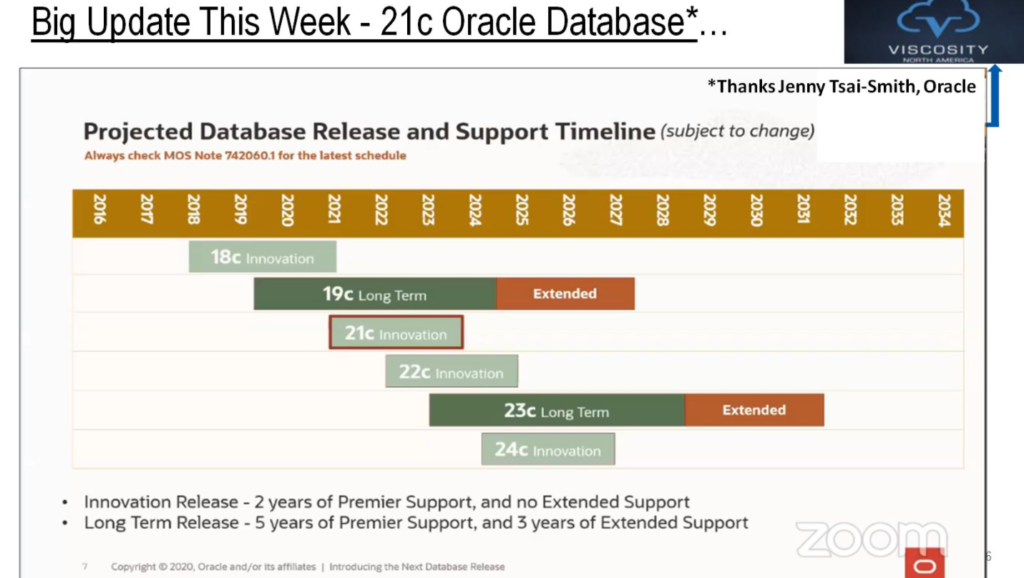Oracle 23ai is made generally available and it has got 300+ new features including AI related.
Here is the list of new features from Oracle Blog (Dominic Giles) and I will write detailed posts on some of these features which may useful to DBAs and Developers.
AI Vector Search
- Oracle Announces General Availability of AI Vector Search in Oracle Database 23ai
- Fortifying Data Security in AI with Oracle’s GenAI Service
Application Development
JSON
- JSON Relational Duality: The Revolutionary Unification of Document, Object, and Relational Models
- Working with JSON-Relational Duality Views and Oracle APEX
- JSON Schema and Data Use Case Domains
MLE/JavaScript
- Working with JSON in Multilingual Engine/JavaScript
- Ad-hoc MLE JavaScript: DBMS_MLE
- Using a proxy with the JavaScript fetch API and UTL_HTTP
- Using faker-js/Faker to generate test data respecting referential integrity
- Using faker-js/SimpleFaker to produce test data
- Performance Monitoring for In-Database JavaScript
- Dealing securely with state changes in Multilingual Engine
- Using the Operating System's certificate store instead of an Oracle wallet
- An Introduction to Post Execution Debugging
- More fun while coding: local dev-environment for MLE
- Enhanced JavaScript Support
- Managing JavaScript modules and environment in Database Actions
- Creating MLE JavaScript Modules in Database Actions
- Using the JavaScript fetch API
- Linting MLE JavaScript Modules in Continuous Integration Pipelines
- Using JavaScript community modules
- MLE type mapping: passing JSON to JavaScript functions
Oracle Cloud Infrastructure
SQL
- Schema Annotations - the new metadata
- List Months of the Year or Days of the Week in Oracle SQL with Enumeration Domains
- More Boolean features
- How to Document Database Objects with Annotations
- Enhanced Querying: Eliminating the “FROM DUAL” Clause
- New value constructor
- Less coding using Data Use Case Domains
- Improved Table Management in Oracle 23c: Introducing the “IF [NOT] EXISTS” Clause
- Simplifying Query Development with Improved GROUP BY and HAVING Clauses
- Boolean Data Type
- Using QuickSQL to generate table DDL and sample data
- UPDATE and DELETE Statements via direct Joins
- Better error messages means less errors
- Introducing the New/Old Returning Clause
- Aggregation over INTERVAL Data Types
Microservices
- Building real-time multi-cloud AI Microservices using TxEventQ, Sagas, TrueCache in Oracle Database 23ai
- Kafka interopability
- Kafka-compatible Java APIs for Transactional Event Queues published
- Playing with Kafka Java Client for TEQ – creating the simplest of producers and consumers
Database Drivers and Application Connectivity
- JDBC Configuration via App Config Providers and Vaults
- JDBC seamless authentication with OCI IAM and Azure AD
- Java and .NET Application Observability with OpenTelemetry and Oracle Database
- How to Make Application Continuity Most Effective
- Oracle .NET Application Continuity — Getting Started
- HikariCP Best Practices for Oracle Database and Spring Boot
General
- New full-text search: Ubiquitous Database Search
- What's New for Java Developers
- Oracle REST Data Services 22.3 brings new REST APIs for Transactional Event Queueing
- Introducing the Oracle Database Observability Exporter
High Availability and Distributed Database
- Oracle Globally Distributed Database supports RAFT Replication
- Oracle’s very own database connection proxy, CMAN-TDM, brings in per-PDB pooling capabilities
- Multi-pool Database Resident Connection Pooling (DRCP)
Performance
- Introducing Oracle True Cache
- Priority Transactions with high, medium and low priority transaction
- Fast Ingest Enhancements
- Lock-free reservations
- SQL Transpiler - automatic PL/SQL conversion into SQL
- Unleashing the Power of Lock-Free Reservations
Security
OLTP and Core Database
Spatial and Graph
- Operational Property Graphs
- Get started with Property Graphs
- Property Graphs in SQL Developer release 23.1
Videos
Application Development
JSON
SQL
- Simple SQL
- GROUP BY column alias
- If NOT exists
- Update/Delete with JOIN
- Schema Annotations
- Table Value Constructor
- Select Without From Clause
- PL/SQL JSON constructor support for aggregate types
- Lock-free column value reservations
- Boolean Data type
- Better Error Messages
- Data Use Case Domains
- DEFAULT ON NULL
- RETURNING NEW/OLD
General
- MongoDB-compatible API
- JavaScript stored procedures
- Kafka APIs
- Application Observability with Enhanced Diagnostic and OpenTelemetry Integration
- Oracle Text - find ANY data in ANY table easily!
Database Drivers and Application Connectivity
- Effortless Connection Management with Implicit Pooling
- Database driver asynchronous programming and pipelining
- Transparent Application Continuity (TAC) for Java
- Async & Reactive Programming, R2DBC, Java Virtual Threads, and Database Pipelining
- Connect Power BI Desktop with Azure Active Directory and Oracle Database






Follow Me!!!